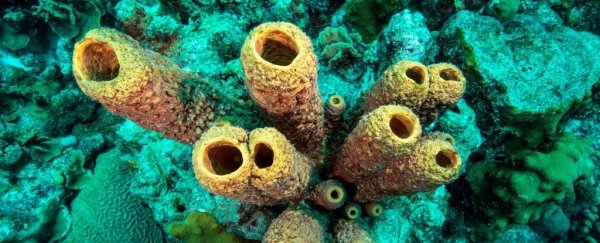The tree of animal life had to begin somewhere. Finding that original branch amongst such a tangled canopy is harder than it sounds, though.
A new analysis of genomic data suggests that one phylum in the running for the oldest branch has been deceiving us all along.
Since the 19th century, many scientists have presented the sponge - one of the simplest creatures in existence - as the world's first animal.
Modern genomic studies, however, have pitted this muscle-less, nerve-less and organ-less blob against a far more complex creature.
Comb jellies comprise a small phylum known as Ctenophora, but unlike Porifera - the phylum sponges belong to - these orb-like creatures show much more advanced traits, including neurons and muscle cells to detect and eat prey, as well as a gut for digestion.
If these jellies actually came first, it means many of their traits were subsequently lost among Porifera, only to evolve again later on. While this might sound downright illogical, it's not entirely out of the question, although it does threaten to change our understanding of early animal evolution and the development of the nervous system itself.
"It may seem very unlikely that such complex traits could evolve twice, independently, but evolution doesn't always follow a simple path," explains geneticist Anthony Redmond from Trinity College Dublin in Ireland.
"For example, birds and bats are distantly related but have independently evolved wings for flight."
In recent years, some models that have split genes up into smaller groups for comparison have found comb jellies hold a greater phylogenetic signal than sponges, which suggests these animals evolved and existed first.
Using the same data, other models that do not partition genes but rely on a larger super-matrix have revealed the exact opposite timeline, with sponges arriving on the scene earlier than comb jellies.
Both of these approaches have their limitations, but examining them together helps alleviate some of our previous errors and biases when looking at the data.
A reanalysis using a more integrative model now suggests we were on the right track to begin with - namely, sponges were it.
"Our approach bridges the gap between two disagreeing methodologies, and provides strong evidence that sponges, and not comb jellies, are our most distant animal relatives," says Redmond.
"This means our last common animal ancestor was morphologically simple and suggests that repeated evolution and/or loss of complex features like a nervous system is less likely than if comb jellies were our most distant animal relatives."
In evolution, natural selection tends to maintain the function and shape of certain proteins by substituting specific amino acids with others that have similar biochemical properties. These properties, however, can differ from site to site, within and between genes.
Partitioned models, where genes are split up and substitution patterns among sites are compared in groups, often do not account for this diversity, which means they could be missing multiple 'hidden' substitutions, especially in species where new amino acids were selected for relatively quickly.
As such, most partitioned models point toward comb jellies as the original sister to other animals. But when models that do account for site differences are incorporated, researchers have found sponges instead take on that role.
This lines up with previous studies that have found partitioned and unpartitioned models can affect branch-lengths and nodes of change on the tree of life, "sometimes dramatically so."
In other words, researchers argue, it is our "poorly fitting" and "overly simplistic" models that are suppressing some evolutionary changes on the long branch of comb jellies. This makes the Ctenophora phylum look like it evolved before sponges, when, in fact, these jellies probably split from Porifera quite early on and then evolved incredibly fast.
The results support a previous study in 2020 that found the rapid evolution of comb jellies introduces a bias into our models that fools us into thinking they came first.
Both the Porifera and Ctenophora phyla have long branches, but when we compare the two using similar amino acid replacement models, the jellies look as though they must be older because of their rapid evolution. In reality, however, the gene sequences of comb jellies have occurred in a much tighter space of time, which makes them seem more closely related to sponges than they actually are.
 Two possible trees for the first phyla in existence. (Telford and Kapli/The Conversation)
Two possible trees for the first phyla in existence. (Telford and Kapli/The Conversation)
Future models need to account for this bias, known as the 'long branch attraction', researchers say, otherwise these discrepancies will keep popping up again and again.
"Long-branched animal groups are often difficult to place," evolutionary biologist Detlev Arendt told Quanta Magazine in 2015.
"So far, the phylogenetic data is not really conclusive on where [comb jellies] belong."
Given how heated this debate has become, it's unlikely this new study will end the conversation for good. That said, the results of this updated model do join other recent advances in genomic research that suggest the genes of comb jellies are somehow throwing us off the scent.
"Consternation over which lineage is sister to other animals has had a major influence on development of novel approaches and reassessment of the quality of commonly applied phylogenetic methodologies," the authors write.
"This looks set to continue, with many avenues of research highlighted by this debate yet to be explored."
The study was published in Nature Communications.
